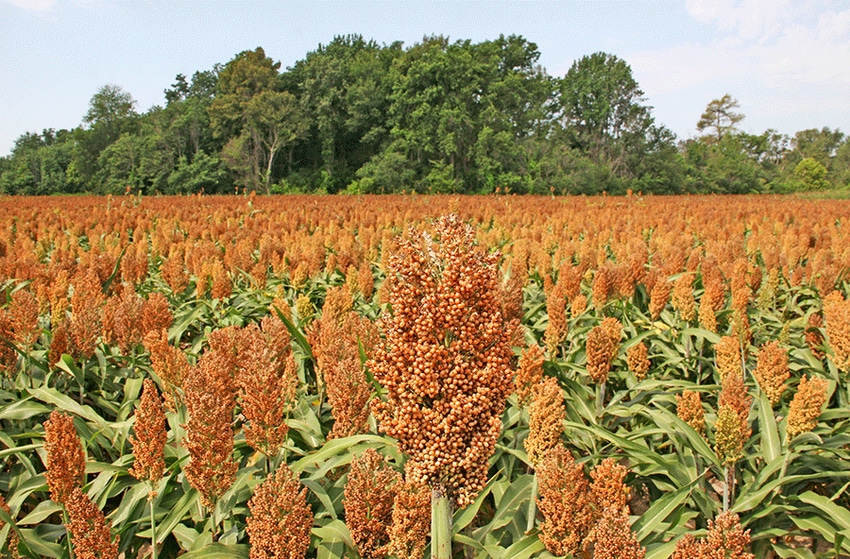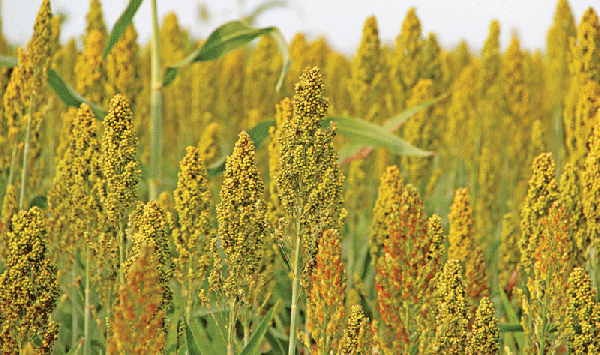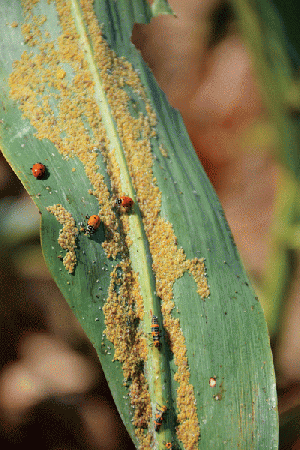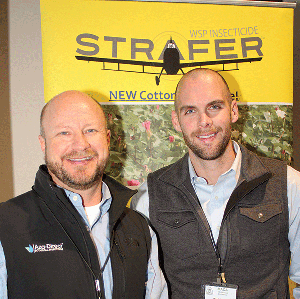
If you’re going to grow grain sorghum this year, you should factor into your plans a solid insect management plan, says Angus Catchot, Mississippi State University Extension professor of entomology and plant pathology.

ANGUS CATCHOT
ANGUS CATCHOT“Going into the season, have a plan to deal with a few of the most common yield robbers: sugarcane aphid, sorghum midge, and the headworm complex,” he said at the annual meeting of the Mississippi Agricultural Consultants Association.
“In a year of low prices for most commodities, it’s been difficult to predict exactly what grain sorghum acreage will be in Mississippi. Based on calls and questions about Transform availability since the first of the year, there’s no doubt growers are thinking about the crop and potential pest problems.”
The penalty for missing a bad midge population “can be severe,” Catchot says. “In the past, when we had small acreages of grain sorghum and sugarcane aphids were not in the picture, we just made an automatic application at about 20 percent bloom. But now, with larger acreages and the potential for flaring sugarcane aphid populations, and even worms to some extent, growers need to be more aware of midge.”
In 2015, he says, “There were some pretty severe yield losses in places, but for the most part we stayed on top of the midge situation.”
IT’S FREE! Stay informed on what’s happening in Mid-South agriculture: Subscribe to Delta Farm Press Daily.
“One of the things I’ve realized the last couple of years is just how little we know about sampling for this insect.,” Catchot says. “So, we’ve started moving back to the scouting model — which I think we should do, because they’re very easy to scout. “Last year, we had higher midge populations than in a long time, and we conducted a number of in-field scout schools and one-on-one training with consultants.�” There has been “misunderstanding about the physiology of the grain sorghum plant,” he says, “and we’ve been working to train our county agents on this.”

Bruce West, from left, Hollandale, Miss., and Brett Dixon, Cleveland, Miss., both with Pinnacle Agriculture LLC, visit with Jim Barrentine, SePro, Fayetteville, Ark., and Bruce Pittman, Bruce Pittman Entomology, Greenwood, Miss. They were attending the annual meeting of the Mississippi Agricultural Consultants Association.
Bruce West, from left, Hollandale, Miss., and Brett Dixon, Cleveland, Miss., both with Pinnacle Agriculture LLC, visit with Jim Barrentine, SePro, Fayetteville, Ark., and Bruce Pittman, Bruce Pittman Entomology, Greenwood, Miss. They were attending the annual meeting of the Mississippi Agricultural Consultants Association.The sorghum head blooms from the top down, Catchot notes, and “in about 4 to 5 days it’s done blooming. The head is no longer susceptible to midge. This is important, because I’ve walked behind dozens of sprays for sorghum midge that were made at the wrong time — in the soft dough stage, when plants had not headed, or in fields that were already bloomed out.”
The sorghum head blooms at about 20 percent to 25 percent per day over that 4 to 5-day period,. “When yellow anthers pop out and the glume opens, that’s when the female midge lays eggs in the glume. If there are enough midges in the field, each individual seed can have an egg in it.
“When anthers turn orange, starting day 2 on the top part of the bloom, it’s over for midge — at that point, that part of the head won’t get midge damage. Only the center part of the head that’s now blooming is susceptible. In day 3 or 4, the head is 60 percent to 90 percent flowered, and only the bottom part is yellow and susceptible to midge.
Monitor sorghum bloom closely
“This is really important,” Catchot says, “because a lot of fields have been sprayed on the wrong timing. What you need to do is track the yellow flowers, and when the top 20 percent to 30 percent of the head is blooming, that’s your target for an application.”

It's important to monitor sorghum plants closely during their short bloom period, when they are susceptible to sorghum midge.
It's important to monitor sorghum plants closely during their short bloom period, when they are susceptible to sorghum midge.Grain sorghum fields “hardly ever flower uniformly,” Catchot says. “But when that first 20 percent to 30 percent is flowering, you cannot think, ‘I’ll wait five more days and make one spray and get 70 percent.’ It will be too late. You’ll have lost that 30 percent on the front side, if midge were present. You’ve got to protect it in stages. Unfortunately, this may mean more than one application. If you want a target threshold, it would be at 20 percent to 30 percent bloom.”
Scouting for midge is easy, he says. “You can readily see the little orange midges on the plants. You can use a gallon Ziploc bag — just pull it over the head, slap the neck of the sorghum plant, lift the bag off, and look at the midges in the top of the bag. This is so simple to do,” he told the consultants. “And if you can save your grower an application, that will add more value to your services. It’s as important to save a spray as to make one.”
Because bees are also sometimes present in sorghum fields during bloom, Catchot notes, it is important to hold midge sprays until closer to sunset. “This will greatly reduce the risk to honeybees and other pollinators.”
Worms in grain sorghum have been a problem to some extent each year, particularly in late-planted fields, he says.
“Whether fall armyworms or corn earworms, 1 per head is our threshold, or 5 per head for sorghum webworms, which we’ve seen more of the last couple of years. The diamides are my first choice for control. I would rather use something like Prevathon or Besiege than Belt. If Prevathon wasn’t available, Belt would be the best option on the table. But it hasn’t performed as well in grain sorghum as the others. Blackhawk is also an option now; we looked at it last year, and it also performed well on worms.”
Sugarcane aphid a devastating pest
The sugarcane aphid, which has spread rapidly across the Southwest and Southeast “is one of the most devastating pests of grain sorghum I’ve dealt with in my career, but only if untreated,” Catchot says. “We’ve dealt extensively with this pest over the past couple of years, and there has been a lot of effort and research devoted to it on a multi-state level.”

Despite its ability of the sugarcane aphid to cause extensive damage to a grain sorghum crop, “It wouldn’t scare me in the least — as long as we have tools to combat it, and they are applied timely,†says Angus Catchot.
Despite its ability of the sugarcane aphid to cause extensive damage to a grain sorghum crop, “It wouldn’t scare me in the least — as long as we have tools to combat it, and they are applied timely,†says Angus Catchot.Despite its ability to cause extensive damage to a crop, he says, “It wouldn’t scare me in the least from growing grain sorghum — as long as we have tools to combat it, and they are applied timely.”
Sugarcane aphids can be a problem season-long but the big population buildups seem to start about mid-July,” Catchot says. “And we’ve learned in the last couple of years that treatment efficacy can be temperature-sensitive.
Keep up with important upcoming events: Delta Farm Press Calendar of Events
“In 2014, there were times when Transform stopped controlling aphids, and we had a lot of calls about it. At first, we thought it might be antagonism from mixing Transform with pyrethroids. Then the situation kind of corrected itself. But a few weeks later, we again started getting calls about lack of efficacy with Transform.” Catchot says Johnny Spivey, with Dow AgroSciences, suggested “it might be the weather; there had been a couple of times when temperatures dropped into the low 60s or upper 50s.
“It turned out he was absolutely right. We did some subsequent work with Transform and Sivanto, including lab assays and putting aphids in 60 degree and 80 degree growth chambers. What we found: It doesn’t matter what the product is — control is very much temperature-related. Efficacy can drop as much as 50 percent to 60 percent at low temperatures. It’s probably just a matter of the aphids not feeding as actively and ingesting the insecticide. If low temperatures last three to five days, it may be that enough residual wears off that when they start feeding again, we don’t get control.
“If you have late-planted grain sorghum and you’re spraying for sugarcane aphids, if the forecast looks like the cold snap will last only a couple of days, try to wait until it’s over to make your application. If the aphid problem is really bad, and you need to deal with it quickly, try to wait until the heat of the day, perhaps 3 p.m., to make your application.”
Making harvest aid decisions

Glenn Kernodle, left, Cabot, Ark., and Brett Helms, Baton Rouge, La., were manning the Gowan booth at the conference.
Glenn Kernodle, left, Cabot, Ark., and Brett Helms, Baton Rouge, La., were manning the Gowan booth at the conference.Catchot says quite a few inquiries have been made about harvest aid applications when there are heavy populations of sugarcane aphids.
“We’re making a lot of applications with Roundup or sodium chlorate at harvest that may or may not be needed. The reason is that the risk of being wrong is severe. You’re not going to lose bushels per acre that late as a direct result of the aphids, but you can have major equipment problems from combines being clogged with the honeydew the aphids secrete. There are numerous incidents of people on turnrows, pressure washing combines, trying to unclog sticky residue. That’s a problem growers want to avoid.
“We’re working diligently on this, and it’s a major concern for grain sorghum growers with regard to harvest aid applications. I think it comes down to this: How much risk is the grower willing to take? The penalty for being wrong can be really high. I suspect most growers would probably rather make a harvest aid application than to spend hours on a turnrow cleaning out combines. We heard the first of the year that numerous combines were at dealerships in Louisiana, clogged up tight from residues covered in sticky aphid honeydew.
“If you’re asking yourself, ‘Should I add something to my harvest aid?’ I would consider what the total aphid load in the plant is — not just what’s in the flag leaf, but also what’s in the lower canopy? If there are very few aphids in the head during the middle of the day, but the bottom third of the plant has a pretty heavy aphid load, those aphids will probably wind up in the head. There’s also some evidence that when the harvest aid is applied, it pushes aphids into the head.”
Catchot showed a video made by one of his students, Ben Thrash, that he says was “really eye-opening” regarding the behavior of aphids
“One of the things we’d been noticing in grain sorghum fields was that there would be few, or no, aphids in the heads, but there were lady beetles all over the heads and the heads were sticky. I wondered where all the honeydew was coming from, because all the aphids were on the bottom of the plants.
“Ben made a time lapse video, showing sorghum plants every five minutes over two days. It showed there wasn’t much aphid activity during the heat of the day (Aug. 1), but at 6 p.m. and during the night, they began moving to the head. They stayed there until daylight, and then started moving back down to the bottom of the plants.
“This was really eye-opening for us, and it may suggest that we can obtain better control of this pest by moving applications into the late afternoon or evening.”
About the Author(s)
You May Also Like




